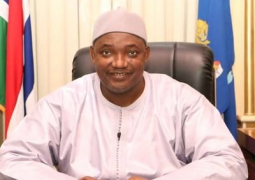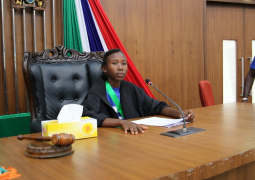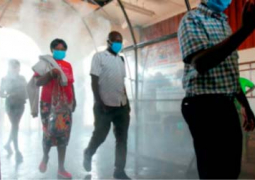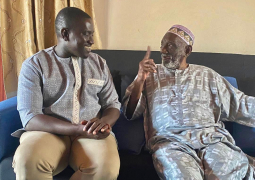Our Founding President His Excellency Alhaji Sir Dawda Kairaba Jawara, GCMRG, was a man of peace. He kept peace a-yard and abroad. Whilst his intrepid efforts to bring peace to Liberia in the early 1990s are well noted by scholars, less has been written by scholars about his other successful peace making adventure- the one he undertook in the early summer of 1975 to normalize the toxic diplomatic relations between Senegal and Guinea Conakry.
From 1958 when Guinea Conakry under President Sekou Toure voted for Independence from France to 1975, the two countries were at a silent war. Sekou Toure, the fierce despot in Conakry, saw Senegal as a Fifth Column primed by France to weaken and overthrow his miserable Revolutionary government. The President of Senegal, Leopold Sedar Senghor, saw Sekou Toure as a useless and blood thirsty ruler who took pleasure in hanging his people in public, or starving them to death at his infamous prison, Camp Boiro.
This toxic animosity between Sekou and Senghor brought untold suffering to the people of the two countries. Sekou Toure took hostages of Senegalese working in Conakry, or even farmers who strayed with their cattle across the border! In turn, Senghor spied on Guinea for France, and also gave shelter and jobs to Guinean anti government exiles in Dakar like the famous writer Camara Laye(1928-1979) or the great historian of Sundiata, DJibril Tamsir Niane(1932-2021). Moreover, the putrid relations between the two countries occasioned regular border closures which hampered trade in the sub-region. Furthermore, the bad blood between the two presidents risked spilling over to swamp newly independent Guinea Bissau which was now caught in between working with Senghor or getting closer to Sekou who helped the PAIGC win the liberation war. A border dispute between Bissau and Conakry was being mooted.
It was within this confused context that Sir Dawda came in to bring normalcy. He made adept diplomatic moves which students of diplomacy should carefully note. First, Sir Dawda contacted Sekou and suggested a peace mission. Sekou accepted. The Guinean president had been very happy about Jawara since 1970 when Jawara, out of form, agreed to deport to Conakry a dozen Guinean rebels who were planning to cross into Guinea to overthrow Sekou Toure. Unfortunately for them, the vigilant Gambian police arrested them at Serekunda. Upon interrogation, it was revealed that the group was the vanguard of a massive invasion force rallied against Conakry by Guinean exiles and Portuguese secret police, the PIDES. Portugal was unhappy with Sekou Toure for his strong support to the PAIGC of Amicar Cabral fighting for Guinea Bissau Independence. Jawara was advised by Chief Justice Sir Phillip Bridges, QC, not to deport the Guineans as Sekou Toure will certainly hang them. But in the spirit of African solidarity and regional stability, Jawara insisted that they be tried for illegal entry and when found guilty, deported. Thanks to this arrest in Serekunda, Sekou Toure got a warning about the impending invasion, which did occur on 24 November 1970, and which he survived. He remained grateful to Jawara ever since.
Second, Sir Dawda invited President Senghor to Banjul who arrived on a short visit on 5th June 1975 accompanied by his Foreign Minister, Assane Seck. In discussions at State House, Senghor accepted Sir Dawda’s peace overtures. So in a jiffy, Jawara has won the trust of both leaders. Sekou Toure and Senghor were so enthused by Jawara’s peace moves that they both offered Jawara the use of their private jets for his impending travels.
Sir Dawda politely rejected both offers. He instead decided to use the mighty River Gambia for his peace mission. He asked his Chief of Protocol, the highly capable Sheikh Jeng to arrange for the use of the presidential boat, the MV Mansa Kila Ba, for the travel from Banjul to Labe, in Guinea, where Jawara wanted the Senghor-Sekou-Jawara peace summit to take place. The River Gambia rises from near Labe. The sea pilot, Master of The Sea and Managing Director of The Gambia Ports Authority, Captain Sallah sailed Sir Dawda’s yatch. Captain Sallah was one of the first African Masters of the Sea and was pilot of the Nkrumah’s Black Star Line MV River Prah. The MV Manska Kila Ba set off from Banjul harbor on June 19 1975 bound for Labe through the River Gambia.
When he arrived at Labe for the summit after three days of sailing, Sir Dawda reportedly quipped to his host in the Mandingo language: ‘I come to seek peace, that is why I use the River Gambia, that we share’. After a day of talks, the three presidents agreed that henceforth Guinea Conakry and Senegal will live in peace. Sir Dawda asked of both presidents to show mutual goodwill. Sekou Toure released a group of Senegalese teachers he held hostage. To make assurance doubly sure, Jawara insisted that the released Senegalese travel with him back to Banjul, and then travel thence to Dakar! Senghor in turn asked his secret service to stop jamming broadcasts from Voix de la revolution, the Guinean radio station.
In a front page story, The Gambia News Bulletin of 31 July 1975 announced: ‘President Jawara Hopeful for Harmonization of Relations Between Senegal and Guinea’, quoting The Gambian leader speaking at a news conference at State House after his return. In another front page story on its July 26 1975 issue, the same newspaper had a headline: ‘Sir Dawda Expresses Gratitude to Guinea Conakry and Guinea Bissau’ after a successful visit.
By any measure, Sir Dawda’s peace mission was a success. He helped to restore ties between Guinea and Senegal. Indeed, in 1978, Sekou Toure paid a visit to Senegal and went as far as Touba to commit his Friday prayers. In 1982, he visited France for the first time in 24 years. By his River Gambia Peace Mission therefore, Sir Dawda brought normalcy to Guinea-Senegal-France ties. This helped to reduce Sekou Toure’s isolation and thereby, his legendary paraonia. In 1978, Sekou Toure visited The Gambia and went as far as Mansakonko. In 1976, President Luiz Cabral of Guinea Bissau had visited Banjul. So The Gambia was really at peace with its neighbours!
The River Gambia Peace Mission was immortalized in a powerful poem titled ‘Khaira tamoo’(Voyage of Peace) by Finance Minister Garba Jahumpa published in The Gambia News Bulletin : ‘Historic Kaira Mission to remove enmity/ between two very esteemed and highly/Respected and friendly neighbours/ members of Mother Africa…’





